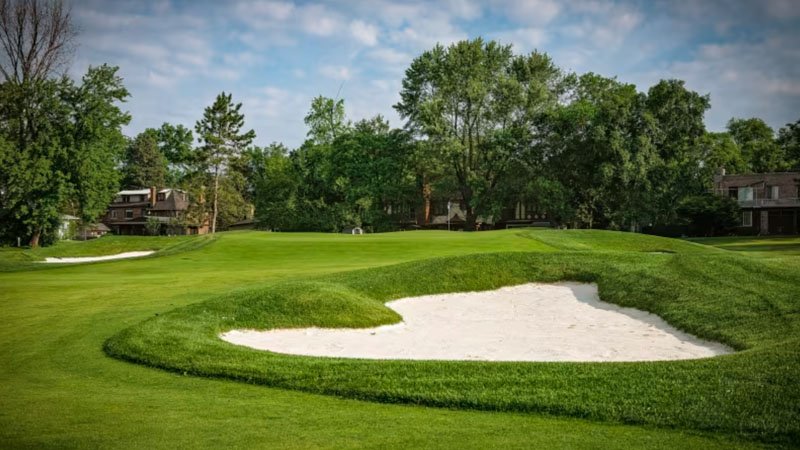
There was a time when the layout at Detroit Golf Club was a model for moving surface water. For years, a system of ditches, gullies and drains that was built into the design by Donald Ross a century ago was a critically important feature of a nearly dead flat golf course with barely 5 feet of total elevation change.
Over time, thanks to things like cart paths and architectural changes in the modern era, those features became lost or partially obstructed. As a result, superintendent Sam Moynihan and his team lose a great deal of valuable time after almost every rain event.
"In the 1910s, '20s, '30s and '40s, there were these large drainage ditches that moved surface water to get it off the playing surface and move it off property," Moynihan said. "With the addition of golf carts, they became filled in, and this created dams and embankments, which led to ponding and flooding."
Reintroducing those land features is an integral part of a $16 million master plan and restoration of North and South courses at Detroit Golf Club by architect Tyler Rae that is scheduled for completion in 2026. Restoration of the North Course will begin after the 2025 Rocket Mortgage Classic, the PGA Tour event that debuted in 2019 at DGC, and will be completed in time for the 2026 tournament.
Rain events that others might consider ho-hum are a big deal at Detroit and result in Moynihan's team spending a lot of time pumping water from one location to another until finally removing it from the golf course.
"Our biggest challenge is drainage," Moynihan said. "Anytime it rains an inch to an inch-and-a-half in 24 hours, everything is flooded — fairways, bunkers. We spend a day or two with pumps moving water from one puddle to another puddle to finally moving it off the golf course. After this project is completed we will get those days back to focus on other things.
"We will be able to get back on the golf course sooner for routine maintenance and improving the experience on the golf course for members and their guests."
Other aspects of the project will include new subsurface drainage, state-of-the-art irrigation system, taking out a pond near the 14th hole and rebuilding pretty much everything from tee to green.

"The members wanted to do a master plan because many of the features on the golf course were coming to their end of life," Moynihan said.
The irrigation system is from 1999, the greens were built to USGA specifications in 1988, the bunkers were redone in 2014 with no liners and perforated pipe in the floors and the drainage is 1920 clay tile.
"The big focus is on drainage, surface and subsurface drainage," Moynihan said. "The members realized this was a unique opportunity to address the golf course features that were nearing the end of life and knock out greens, bunkers and tees and set up the club for success over the next 20 years."
Rae was picked by the club's Special Projects Committee from a long list of prospective applicants after the club solicited RFPs. A student of Ross's work, Rae studied under Ron Prichard and Keith Foster and was brought aboard to design Spy Ring Golf Club, the nine-hole revamped version of the former Ross-designed Heatherwood Golf Club on Long Island.
His renovation work of Seth Raynor's work at Lookout Mountain Club in Georgia was named the Golf Digest 2023 Renovation of the Year. Other highly regarded projects by Rae include the restoration of Wampanoag Country Club, another Ross design in Connecticut, and the Wakonda Club in Iowa.
The project will also include removing trees and widening fairways that have narrowed over time. To that end, Rae and the club have an extensive array of vintage aerial photography of the club from its early days from both local sources and the Tufts Archives in Pinehurst from which to draw inspiration for the restoration.
The property has a lot of old growth oaks that are as old as the club that are both strategic and have become favored by the club. It also has a lot of pines that have to be removed. A final tally of just how many trees must be removed will be clear after
Rae's arborist completes an inventory.
"There are a lot of 100- to 150-year-old oaks that we want to save and highlight," Moynihan said. "There are a lot of nursery stock trees that don't have the same value."
Early photography of the course yielded yet another discovery, the use of sand-flashed bunker faces that over time have been replaced with turf. Over time, those bunkers were moved to the typical locations — the outer edges of fairway landing areas and the sides of greens. They will be replaced with the historically accurate sand-flashed bunkers in fairways and in front of greens where they will become not only true hazards but visible from tees and fairways.

"This way, from the tee golfers will be able to see the hazard and not just a mound," Moynihan said. "And they will be moved back to where they are an integral part of the golf course."
At some point in DGC's history, a small pond, about a half-acre in size, was installed near No. 14. At only 3-4 feet in depth, it is not used for irrigation and actually impedes recovery efforts during rain events. Rae's plans include draining the pond and connecting the resulting depressed area to the array of drainage ditches.
Moynihan's previous experience includes a lot of construction and project experience prepping under Paul Latshaw, CGCS and Chad Mark, CGCS at Muirfield Village in Dublin, Ohio five years as assistant at Caves Valley in Owings Mills, Maryland, under superintendent Kyle Steidel, another Latshaw protege from Muirfield.
"Every fall, we were always doing projects at Muirfield," he said. "Paul's goal every year was to add another mile of drainage."
He was able to see some of Rae's work first hand after the renovation of Green Spring Valley Hunt Club, also in Owings Mills.
"That's another low-lying property with some drainage problems, and Tyler was able to get in there and amplify the experience for their members," he said. "That's the biggest thing here is drainage. There's been erosion, sedimentation and shallowing up. We're going to do a lot of ditch work."
There is a reason for much optimism at Detroit Golf Club. Since the Tour event debuted five years ago, initiation fees are way up, as is membership. Work on the 36 holes that Ross began designing in 2013 comes on the heels of a $9 million clubhouse renovation.
"I think everybody here is really excited for the opportunity we have here," Moynihan said. "We have a chance to honor the history of Detroit Golf Club. The club itself has been around since 1899, and we want to make sure it is around for another 100 years."


